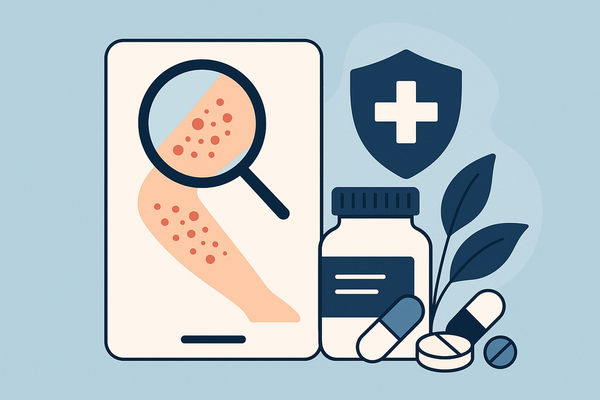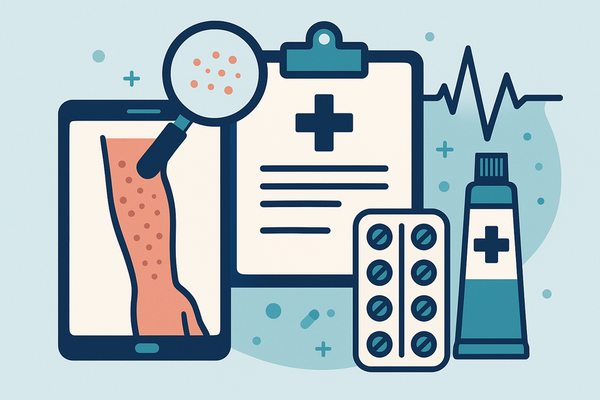Interpreting Rash Diagnosis Confidence Scores in AI Reports
Explore how to interpret rash diagnosis confidence scores from AI-generated reports. Understand score significance and its role in informed dermatological decisions.

Estimated reading time: 7 minutes
Key Takeaways
- AI rash reports assign a confidence score (0–100%) to each possible diagnosis.
- High (≥80%), moderate (50–79%), and low (<50%) scores guide your next steps.
- Many factors—image quality, training data, model design—affect score reliability.
- Always validate AI findings with clinical context and trusted resources.
- Seek professional evaluation when confidence is low or symptoms worsen.
Table of Contents
- What Are AI-Generated Rash Reports?
- Understanding Rash Diagnosis Confidence Scores
- How to Interpret Your Scores
- Practical Tips for Evaluating AI Diagnoses
- Limitations and Considerations
- Conclusion
Section 1: What Are AI-Generated Rash Reports?
AI-generated rash reports leverage computer vision and deep-learning models trained on vast dermatology image collections to propose potential diagnoses. The process typically involves:
- Image upload: Capture or upload a clear photo of your rash.
- Feature extraction: The AI examines color, shape and distribution.
- Comparison: The model matches features against its training images.
- Output: A ranked list of conditions, each with a confidence score.
Benefits:
- Rapid, convenient prediagnosis screening.
- Flags urgent or rare conditions for quick attention (AI-Derm).
- Augments clinician workflows and powers teledermatology (First Derm AI dermatology).
Limitations:
- Struggles with rare or atypical rashes due to limited examples (Dermatology Times).
- Ignores patient history, systemic symptoms and physical exams.
- Accuracy depends on image quality and diversity of the dataset.
Apps like Rash Detector instantly return a confidence-based report. Below is an example sample report illustrating scores and recommended next steps.

Section 2: Understanding Rash Diagnosis Confidence Scores
A confidence score is a numeric estimate (0–1 or 0%–100%) of how sure the AI is about its top diagnosis.
Calculation factors include:
- Visual similarity to training images.
- Distinctive features detected (color, shape, distribution).
- Photo resolution and lighting.
- Model architecture and breadth of learned conditions (MN CIDRAP study).
Illustrative examples:
- 90% indicates strong feature match (e.g., psoriasis).
- 50% suggests multiple plausible diagnoses.
- Below 30% implies low reliability; retake or seek expertise.
Section 3: How to Interpret Your Scores
High Confidence (≥80%)
Likely accurate for common conditions. Treat as a preliminary guide but confirm clinically.
Moderate Confidence (50–79%)
Plausible but not definitive. Recommend follow-up evaluation.
Low Confidence (<50%)
Speculative diagnosis. Professional assessment required.
Reliability Caveats:
- High scores can be inflated by image artifacts or overrepresented classes.
- Always weigh symptom severity, duration and personal risk factors.
Recommended Next Steps:
- ≥80%: Monitor changes, gather symptom details, schedule routine check.
- 50–79%: Consult a dermatologist or primary care for targeted tests (biopsy, cultures).
- <50%: Prioritize prompt professional evaluation.
Section 4: Practical Tips for Evaluating AI Diagnoses
Cross-referencing Strategies:
- Compare AI results with trusted medical sites or textbooks.
- Use a second AI tool for a “second opinion,” but don’t treat conflicts as final.
- Track new or evolving signs (itching, scaling, systemic symptoms).
Validation Checklist:
- Ensure image clarity: good lighting, focus, full rash visible.
- Review AI’s rationale or highlighted features if available.
- Date-stamp and document rash progression.
- Compile findings and confidence score for your healthcare provider.
Section 5: Limitations and Considerations
Data Quality Pitfalls:
- Poor lighting, low resolution or occlusions mislead the model.
Model Biases:
- Overrepresented skin types or conditions can skew confidence.
Unaccounted Variables:
- Age, ethnicity, comorbidities and systemic symptoms aren’t factored in.
Remember: No AI report should replace clinical diagnosis—always seek professional evaluation for a definitive diagnosis (YouTube video).
Conclusion
You’ve learned what AI-generated rash reports are, how confidence scores work and what actions to take at different levels. With practical validation tips and an understanding of limitations, you can use AI responsibly as a supplemental tool. When in doubt, consult a dermatologist.
FAQ
- Q: Are AI rash reports as reliable as a dermatologist?
A: AI can screen quickly but lacks full clinical context—always confirm with a professional. - Q: What affects confidence scores most?
A: Image quality and the diversity of the AI’s training dataset have the biggest impact. - Q: Should I retake photos if the score is low?
A: Yes. Better lighting and focus can significantly improve reliability. - Q: Can I use multiple AI apps together?
A: You can compare results, but avoid treating conflicting outputs as conclusive.





